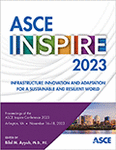Calibration of Concrete Bridge Condition Deterioration for Climate Change Impact Evaluation
Publication: ASCE Inspire 2023
ABSTRACT
Carbonation and chlorination are two major deterioration mechanisms that threaten the structural integrity and serviceability of reinforced concrete bridges. How the changing climate will affect the bridge deterioration and conditions in the long run is yet to be understood. Although Markov-based models are widely adopted in bridge condition deterioration modeling and asset management, these data-driven models are developed solely based on historically observed data (e.g., the NBI data) under the stationarity assumption and cannot robustly accommodate future climate changes. In this regard, this research aims at integrating mechanics-based deterioration modeling, which is physics-based and can better capture the environmental stressor variations, for bridge condition deterioration prediction under the changing climate. Specifically, material-level corrosion damage risks are first estimated by coupling mechanics-based deterioration models with climate data. The influence of existing concrete crack width on corrosion initiation and propagation is for the first time investigated in this context. Risk quantification is carried out via Monte-Carlo simulations by considering various sources of uncertainties. Finally, we established and calibrated the mapping from material-level corrosion damage risks to bridge component-level NBI ratings.
Get full access to this article
View all available purchase options and get full access to this chapter.
REFERENCES
ACI (American Concrete Institute). (2001). Building code requirements for structural concrete (ACI 318-01) : an ACI standard ; Commentary on building code requirements for structural concrete (ACI 318R-01). Farmington Hills, MI: American Concrete Institute.
Aldea, C.-M., Shah, S. P., and Karr, A. (1999). Effect of cracking on water and chloride permeability of concrete. Journal of Materials in Civil Engineering, 11(3), 181–187.
NBI (National Bridge Inventory). (2021). Bridges & Structures. US Department of Transportation/Federal Highway Administration. (n.d.). https://www.fhwa.dot.gov/bridge/nbi.cfm.
Castel, A., François, R., and Arliguie, G. (1999). Effect of loading on carbonation penetration in reinforced concrete elements. Cement and Concrete Research, 29(4), 561–565.
Du, A., and Cai, J. (2022). Climate Change Impacts on Reinforced Concrete Deterioration for Texas Highway Bridges. In Tran-SET (pp. 270–279).
Du, A., and Ghavidel, A. (2022). Parameterized deep reinforcement learning-enabled maintenance decision-support and life-cycle risk assessment for highway bridge portfolios. Structural Safety, 97, 102221.
El Maaddawy, T., and Soudki, K. (2007). A model for prediction of time from corrosion initiation to corrosion cracking. Cement and concrete composites, 29(3), 168–175.
Hu, N., Burgueño, R., Haider, S. W., and Sun, Y. (2016). Framework for estimating bridge-deck chloride-induced degradation from local modeling to global asset assessment. Journal of Bridge Engineering, 21(9), 06016005.
Kwon, S.-J., and Na, U.-J. (2011). Prediction of durability for RC columns with crack and joint under carbonation based on probabilistic approach. International Journal of Concrete Structures and Materials, 5(1), 11–18.
Kwon, S. J., Na, U. J., Park, S. S., and Jung, S. H. (2009). Service life prediction of concrete wharves with early-aged crack: Probabilistic approach for chloride diffusion. Structural Safety, 31(1), 75–83.
MDOT (Michigan Department of Transportation). (2009). Michigan structure inventory and appraisal coding guide. Mic.
Mullard, J. A., and Stewart, M. G. (2011). Corrosion-Induced Cover Cracking: New Test Data and Predictive Models. ACI Structural Journal, 108(1).
Robelin, C.-A., and Madanat, S. M. (2007). History-dependent bridge deck maintenance and replacement optimization with Markov decision processes. Journal of Infrastructure Systems, 13(3), 195–201.
Stewart, M. G., Wang, X., and Nguyen, M. N. (2011). Climate change impact and risks of concrete infrastructure deterioration. Engineering structures, 33(4), 1326–1337.
TxDOT (Texas Department of Transportation). (2020). Report on Texas Bridges. Bridge Division Texas Department of Transportation.
Veshosky, D., Beidleman, C. R., Buetow, G. W., and Demir, M. (1994). Comparative analysis of bridge superstructure deterioration. Journal of Structural Engineering, 120(7), 2123–2136.
Wang, F., Lee, C.-C. B., and Gharaibeh, N. G. (2022). Network-level bridge deterioration prediction models that consider the effect of maintenance and rehabilitation. Journal of Infrastructure Systems, 28(1), 05021009.
Wu, D., Yuan, C., Kumfer, W., and Liu, H. (2017). A life-cycle optimization model using semi-markov process for highway bridge maintenance. Applied Mathematical Modelling, 43, 45–60.
Yoon, I.-S., Çopuroğlu, O., and Park, K.-B. (2007). Effect of global climatic change on carbonation progress of concrete. Atmospheric environment, 41(34), 7274–7285.
Information & Authors
Information
Published In
History
Published online: Nov 14, 2023
Authors
Metrics & Citations
Metrics
Citations
Download citation
If you have the appropriate software installed, you can download article citation data to the citation manager of your choice. Simply select your manager software from the list below and click Download.
